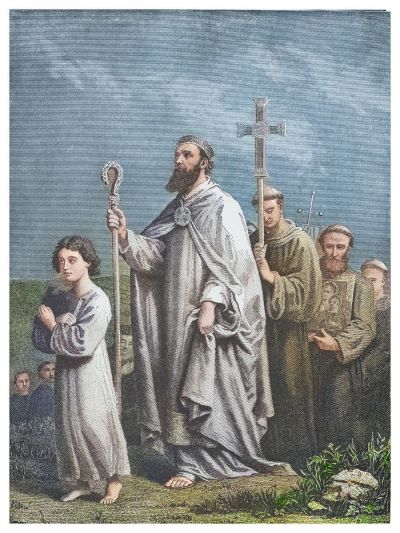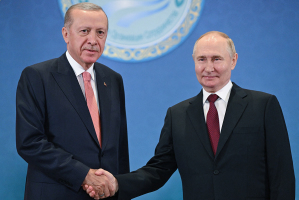Saint Patrick: What’s true and what’s legend?

On March 17, people throughout the world celebrate St. Patrick’s Day as a festive occasion. There are parades, singing, dancing, and toasting, yet how many of the celebrants know why we pay tribute to the man behind the big event?
Each month we receive a publication from The Voice of the Martyrs ministry that educates people on persecuted Christians. Why do they feature someone like the legendary Irishman? Why do they mention uncomfortable words like “slavery, suffering and smuggling of children” in connection with this famous figure?
In these exciting days of history when reports of revival are surfacing as we repent of sin and turn back to God, consider how an entire nation was transformed by one humble man who wrote the following in his memoir, Confessions: “The Lord opened my senses to my unbelief so that, though late in the day, I might remember my many sins and turn to the Lord my God with all my heart.”
From this contrition and subsequent consecration to God came a man who impacted the world! Let’s examine what is legend and what is true about Saint Patrick.
Legendary lore laid aside
- Patrick was not Irish.
- As a young man he had no interest in God.
- He never drove out any snakes because there were none in Ireland.
- His use of a shamrock to teach the Trinity is cute for children, but it's just a myth.
- Leprechauns do not exist!
With St. Patrick's Day and all the green color, parades, parties with Irish stew, and Guinness toasts to the “luck of the Irish,” let's separate what isn't true to focus on the man who transformed a nation. What was behind a man that led Irish celebrants to annually dye the Chicago River green? After all, he died over 1,500 years ago on March 17, AD 461.
The real story
Patrick was born in Scotland around A.D. 387. He was raised in a Christian family, but his interest in God was almost nonexistent. Around the age of 14, he was kidnapped by thugs and taken hostage on a ship to Ireland.
For six years, he was a slave toiling as a shepherd. In desperation, he began to cry out to God, writing in Confessions, "I would pray constantly during the daylight hours" until finally God broke through and revealed Himself in a dream and said, "'Your hunger is rewarded. You are going home. Look, your ship is ready.'"
Patrick departs
He saw the ship and snuck aboard. It was going to Britain. He knew God was taking him back home as he journeyed some 200 miles from the Irish coast!
Patrick finally returned to his family and later entered a monastery and became a minister of the Gospel. Eventually, God led him to go back to the pagan land of Ireland to evangelize the people mired in darkness.
Patrick would face a hostile culture of pagans known for their angry outbursts and violent behavior.
Patrick wrote, "I am ready to be murdered, betrayed, enslaved — whatever may come my way!" In the face of mockery and physical opposition (history records he was beaten by thugs and harassed by Irish royalty), Patrick persevered in proclaiming the Gospel and training converts in their newfound faith.
Jesus revolution
Tens of thousands of Irish were converted and hundreds of churches were established! Thomas Cahill writes in his book, How the Irish Saved Civilization, that this warrior populace "laid down the swords of battle, flung away the knives of sacrifice, and cast away their chains of slavery."
From the fall of Rome, culture was disintegrating on the European continent. Cahill honors Patrick, writing: "The Irish not only were conservators of civilization, but became shapers of the medieval mind, putting their unique stamp on Western culture."
One hundred years after Patrick's death in A.D. 461, multitudes of churches and monasteries remained, training future leaders as a testimony to this mighty man of God. His legacy should make us "green with envy."
May Patrick's courage ignite something in our hearts to reject silence and cowardice in the face of our cultural attacks today. "For the sake of Zion, I will not keep silent … I will not rest until her righteousness goes forth as brightness and her salvation as a lamp that burns" (Isaiah 62:1). Let's follow this world changer in lifestyle evangelism and the courageous proclamation of truth.
“Christ be with me, Christ within me, Christ behind me, Christ before
me, Christ beside me, Christ go with me, Christ, to comfort and
restore me, Christ beneath me, Christ before me, Christ in quiet, Christ
in danger, Christ in the hearts of all who love Him.” — Saint Patrick
Larry Tomczak author of 10 books, is a cultural commentator of 50 yrs, Intercessors for America board member, best-selling author and a public policy adviser with Liberty Counsel. His new, innovative video/book, BULLSEYE, develops informed influencers in 30 days (see www.bullseyechallenge.com). and he has a variety of resources on his website (see www.larrytomczak.com). You can also hear his weekly podcast here.




























